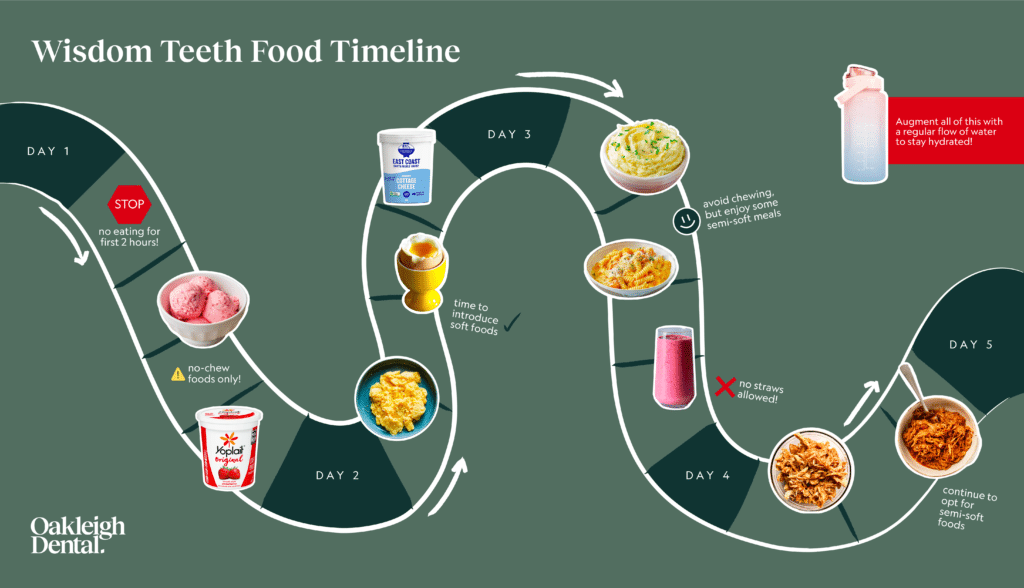When Can I Eat Solid Food After Tooth Extraction
You can typically eat solid food once you feel comfortable after a tooth extraction, usually after a week. Consult with your dentist for personalized advice.
Experiencing a tooth extraction often leads to the question of when everyday eating habits can resume. Solid food reintroduction is a critical component of the healing process. Dentists generally recommend gradually returning to a regular diet to avoid disrupting the extraction site.
During the initial 24 to 48 hours, patients should stick to soft foods and liquids to help heal. Following this, you can introduce semi-solid foods if they don’t cause discomfort. Listening to your body and avoiding any food that might stress the tender area is essential. By taking these steps and maintaining oral hygiene, you can help ensure a smooth recovery. Remember, patient guidelines may vary. Hence, a follow-up with a dental professional is critical for personalized care.

Introduction To Tooth Extraction And Recovery
Tooth extraction requires careful healing. After removing a tooth, your mouth needs time. Recovery varies among individuals. Generally, solid foods are avoided immediately after surgery. Dentists suggest soft food diets initially. This helps to prevent complications.
The healing process involves several stages. The first 24 hours are crucial for clot formation. You should rest and avoid disturbing the extraction site. The following days need caution with food choices. Keeping the mouth clean is vital for recovery. It helps to prevent infections and complications.
| Days 1-2 | Only liquids and no chewing |
| Days 3-7 | Soft foods like yogurt and applesauce |
| Day 8+ | Gradually add semi-solid foods |
Eating solid foods depends on healing speed. Every person heals differently. Your dentist will give the best advice. Following their instructions is essential for a smooth recovery. Solid foods can typically be reintroduced after the first week. Yet, only if there is no swelling or pain.

Credit: oakleighdental.com.au
Nutritional Considerations After Tooth Extraction
Nutrition plays a crucial role in healing after a tooth extraction. The right foods can speed up recovery. Your body needs vitamins, minerals, and proteins to fix tissue. But some foods may harm the wound. Your mouth will be sensitive. It needs gentle care.
Steer clear of spicy and acidic foods. They can irritate the wound. Skip foods that are hard, crunchy, or chewy. These foods can disturb the clot. Hot foods and drinks are a no-go. They can increase swelling. Please stay away from them to help with healing.
| Avoid | Reason |
| Nuts and seeds | It can get stuck in the wound |
| Popcorn | It may disturb the clot |
| Hard breads | Too tough on wound |
| Spicy foods | May irritate wound |
| Alcohol | Slows down healing |
Transitioning To Solid Foods
After a tooth extraction, knowing when to start solid foods is crucial. Your mouth needs time to heal. Look for specific signs of readiness for solid foods. Feeling less pain and reduced swelling are good signs. Also, if the extraction site stops bleeding, that’s important. Once these signs appear, you might consider some solid foods.
Recommended solid foods include mashed potatoes and soft fruits. You can eat scrambled eggs, oatmeal, and fish too. These foods are gentle on your healing gums. Remember, eating hard or crunchy foods could harm your recovery.
- Choose soft, easy-to-chew foods.
- Eat slowly and bite carefully.
- Avoid using straws, as sucking can disturb the extraction site.
- Keep foods at room temperature to prevent sensitivity.
- Stay hydrated with plenty of fluids.
Common Concerns And Complications
After tooth extraction, waiting to eat solid food is crucial. Typically, solid foods are off-limits for at least 24 to 48 hours. During your diet transition, experience some pain and discomfort. To manage, opt for soft, cold foods like yogurt or applesauce and take prescribed pain medication. Chewing on the opposite side of the extraction site can also help.
A dry socket is a common complication to be wary of. It occurs when the blood clot at the extraction site fails to form or dislodges. To prevent it, avoid sucking actions, like using a straw, and refrain from smoking. Gently rinse with salt water after meals to keep the area clean.
Seek medical advice if experiencing intense pain, bleeding that won’t stop, or signs of infection such as fever. These symptoms can indicate a more serious issue, and timely consultation with your dentist is essential.

Credit: franklin-dental-supply.com
Frequently Asked Questions For When Can I Eat Solid Food After Tooth Extraction
How Soon After Tooth Extraction Can I Eat Solid Food?
After tooth extraction, waiting at least 24 to 48 hours before eating solid foods is recommended. Start with soft and easy-to-chew foods to avoid disturbing the extraction site.
What Solid Foods Are Safe To Eat Post-tooth Extraction?
Once ready for solid foods, choose soft food options such as scrambled eggs, mashed potatoes, and well-cooked vegetables. Avoid hard, sticky, or chewy foods to protect the extraction site.
Can I Eat Solid Food If My Extraction Site Is Still Sore?
If your extraction site is sore, it’s best to stick to softer foods and avoid solids that require extensive chewing. Solid foods can be gradually reintroduced as the soreness subsides and healing progresses.
Does The Type Of Extraction Affect Food Choices Afterward?
Yes, the complexity of the extraction impacts food choices. Surgical extractions may require a longer soft food diet compared to simple extractions. Always follow your dentist’s specific dietary recommendations post-procedure.
Conclusion
Timing your return to solid foods is crucial for healing after a tooth extraction. Each patient’s recovery varies, so follow your dentist’s advice closely. Generally, soft foods are recommended for the first 24 hours, gradually reintroducing firmer foods as comfort permits.
Remember, patience and gentle choices will pave the way for a smooth recovery, ensuring your mouth heals optimally before enjoying your favorite solid meals again.